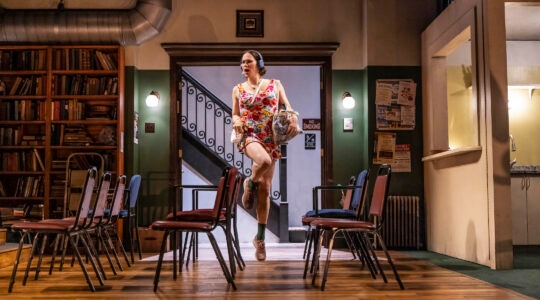When history touched Yonia Fain’s life, it hit with gale force. For 30 years he was "dragged by the storm of events over half a world," the Brooklyn-based painter and Yiddish poet once wrote.
Between 1923 (when a 9-year-old Fain and his family fled Bolshevik Russia, and 1953) when he settled in New York City: Fain outran Nazi troops in Poland, was imprisoned by the Soviets, escaped to Japan, was deported to China and eventually made his way to safety and artistic success in Mexico.
"My work is not just the experience of an individual, it’s the experience of a whole generation," Fain, 90, told The Jewish Week during an interview at his brownstone studio in Carroll Gardens, Brooklyn.
As he spoke, Richard McBee, a painter, arts writer and independent curator, sorted through racks of large-scale oil paintings and knee-high stacks of more recent pastels on paper.
"Richard, are you cursing me?" Fain called out in accented English, with a nod to his prolific output: hundreds of ghetto scenes and Holocaust uprisings, biblical themes, and depictions of the artist in his studio.
"I’m definitely laboring under the burden," McBee said.
Ultimately about 20 paintings and pastels will be included in the exhibition "Shards Across Time ó Kristallnacht: 1938-2003," which McBee is curating. Also included will be works by another Holocaust survivor, Pinchas Shaar, whose fantastical paintings recall the spirit of his Jewish childhood in prewar Poland.
The exhibition opens Nov. 8 at the Brooklyn Jewish Artists Gallery in Park Slope. (See Arts Guide on page 46 for details.)
"Shards Across Time" commemorates the 65th anniversary of Kristallnacht, but McBee concedes that neither Fain nor Shaar, who died in 1998, were in Germany at the time of the Nazi pogrom known as the "Night of Broken Glass."
That early anti-Jewish action, however, "ultimately affected them because they were swept up in what happened after," McBee said. The artists’ creative lives have been "a reflection back on those events."
Fain can’t seem to shake the war’s phantoms. Two of his later oil paintings, included in the Brooklyn exhibition, are 11-foot abstract works, "The Holocaust" and "The Landscape of Echoes" (both 1990-1997).
In figurative works Fain returns often to the themes of struggle and devastation. One repeated motif is discarded clothing (reminiscent of concentration camp uniforms) caught on wire or slung over a chair.
But Fain is doing more than exorcizing ghosts. To McBee, his generalized imagery presents the Nazi genocide as "the tragedy of man."
Fain’s artistic social consciousness attracted the attention of the Mexican muralist Diego Rivera, who befriended the Jewish refugee shortly after his arrival in Mexico City. Rivera sponsored Fain’s one-man exhibition at the Palacio de las Bellas Artes in 1948 and wrote of his paintings: "Just as life attacked and shook him, so he seems with his brush to attack the canvas."
Even before the war, Fain was driven to represent historical reality. As a student at the art academy in Vilna, he found himself unable to complete his final assignment ó to paint a figure from Greek mythology. Fain found more inspiration in a political demonstration he saw through the window.
"I want to paint what is taking place," Fain recalled telling his instructor, who replied: "That’s life. This is art. Stick to art."
Fain could not. Years later, in Shanghai after the war’s end, Fain read about Mexican muralists like Rivera, whose realistic work glorified the common man and revolutionary fervor.
"That was what I was looking for," he said. "To paint history, not still life."
Fain’s largest work to date is a 600-square-foot mural devoted to the Warsaw Ghetto Uprising that remains today in the cupola of Mexico City’s Pantheon Dolores.
"It wasn’t sentimental or propaganda," Fain said of the monumental painting, completed in 1949. "It was the experience of somebody who fought for his life, for the life of his people."
The New York Jewish Week brings you the stories behind the headlines, keeping you connected to Jewish life in New York. Help sustain the reporting you trust by donating today.




